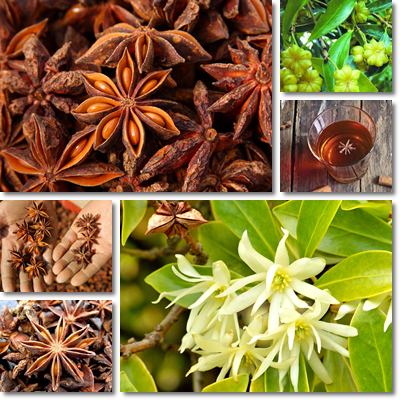Similar in flavor to anise and fennel, star anise (Illicium verum) is a preferred spice throughout the world. Star anise is actually the fruit of a tree native to northern Vietnam and southern China, but being extensively used for flavoring food has lead to it being known exclusively as a culinary spice.
Because of its health-relevant chemical constituents and polyphenols, regular consumption is believed to be beneficial for our health.
Star anise is best known for its digestive benefits. Folk medicine recommends it for treating bloating and flatulence. Drinking tea made from the dried fruit is believed to help relieve indigestion as well as offer antioxidant protection.
Research on its properties reveals star anise and its derivative essential oil possess quite potent antibacterial, antifungal, antiviral and anti-inflammatory properties, as well as a mild sedative effect.

What does star anise look like?
As mentioned above, anise is the fruit of an Asian tropical tree. It is shaped like a flower, or an eight-pointed star, hence the name star anise. Each petal look-alike contains one pea-sized seed, making star anise a seed pod. Unripe star anise has a more plump appearance and a beautiful, light green color. The fruit is usually picked before it matures and dried, hence its tough, deep, rust-colored skin. Star anise is about 2.5 cm (1 inch) long.
What does star anise taste and smell like?
The similarities in terms of smell and taste of star anise, licorice, anise, fennel seeds, fennel and other spices are a result of a chemical constituent occurring naturally in the plants, anethole. For this reason, star anise if often compared to licorice, anise or fennel when it comes to its taste and smell.
Although anise and star anise can be used interchangeably in cooking recipes, the latter has a stronger, slightly more bitter flavor and a mild licorice aroma. Star anise flavor is rich, yet subtle and pleasant. Also see benefits of anise.
Star anise can be used for virtually any recipe, from desserts such as ginger or lemon cookies to bread recipes with a twist, broths, tea, beef and so on. It goes really well with any recipe employing cinnamon, ginger, anise, oranges or lemons. For example, it is a preferred spice used for making mulled wine.
As far as health benefits are concerned, know that star anise has been traditionally employed for the treatment of a variety of ailments, conditions and disorders having to do with the digestive or respiratory system or the immune function.

What is star anise good for?
Here is a list of the top 5 properties and health benefits of star anise:
1) Great digestive aid.
Star anise is known to help reduce bloating and gas, aid digestion as well as treat indigestion and associated abdominal pain (it is also a mild sedative). Drinking star anise tea, flavoring soups and other dishes with the ground spice or cooking several seed pods together with the other ingredients in a recipe is believed to have an overall beneficial action on one’s digestion.
2) Potent antibacterial and antiviral properties.
Studies on the antimicrobial properties of star anise show the spice has quite potent antibacterial and antiviral properties (Antimicrobial properties of star anise Illicium verum Hook f). It has been found to be effective against Escherichia coli, Staphylococcus aureus and other dozens of antibiotic-resistant pathogen strains (source).
As evidence of its potency, star anise is used to obtain shikimic acid, a compound needed to make a famous antiviral medication (Oseltamivir) prescribed for the prevention and treatment of influenza A and influenza B viruses that can infect birds, humans and seals (Illicium verum: A review on its botany, traditional use, chemistry and pharmacology).
Anethole, the main chemical constituent in star anise and other spices and herbs with similar aroma, is believed to be the main antimicrobial agent. Its action may be as powerful as to prevent sepsis or related health risks (Preventive agents against sepsis and new phenylpropanoid glucosides from the fruits of Illicium verum).
3) Boast antifungal action.
Research suggests star anise is effective against fungi such as yeasts and molds, particularly Candida, a type of yeast that can cause severe infections of the gastrointestinal tract, skin, etc. (source). Several medicine journals (Bioorganic and Medicinal Chemistry, Chemistry of Natural Compounds) report anethole to be the main antifungal agent in star anise.
4) Exhibits antioxidant and anti-inflammatory action.
Star anise is rich in polyphenolic compounds and chemical constituents with various health effects. Flavonoids such as kaempferol, quercetin as well as phenolic compounds such as caffeic acid, p-coumaric acid, etc. have been shown to have antioxidant properties and inhibit carcinogenesis.
5) Potentially useful in managing sleep disorders.
Though not as potent as valerian or St. John’s wort, star anise has a mildly sedative action as well as a result of certain chemical constituents in the plant, notably anethole. Tea made from the dried seed pods is believed to have a calming effect that may help relieve insomnia, induce sleep and improve sleep quality.
As long as it is consumed in very small amounts, star anise has been shown to exert a beneficial action on our health. And while it might not perform miracles, its antibacterial, antiviral, antifungal, anti-inflammatory and antioxidant action within our body can contribute to better health. However, it should not be confused with Japanese star anise (Illicium anisatum) a highly toxic variety related and quite similar to star anise.
